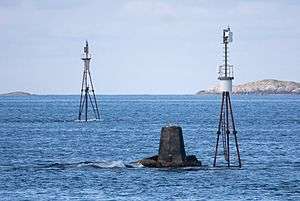MS Sleipner
.jpg) M/S Sleipner entering Vågen, Bergen | |
| History | |
|---|---|
| Name: | MS Sleipner |
| Namesake: | Sleipnir |
| Owner: | Hardanger Sunnhordlandske Dampskipsselskap |
| Awarded: | 27 March 1998[1] |
| Builder: | Austal Ships Pty., Henderson, Australia[1] |
| Yard number: | 83[1] |
| Laid down: | 28 June 1998[1] |
| Launched: | 24 February 1999[1] |
| Acquired: | 18 August 1999[1] |
| In service: | 25 August 1999[1] |
| Identification: | IMO number: 9193032 |
| Fate: | Sank, 26 November 1999 |
| General characteristics [1] | |
| Tonnage: | 375 GT |
| Length: | |
| Beam: | 12.5 m (41 ft 0 in) |
| Draught: | 1.76 m (5 ft 9 in) |
| Depth: | 9.2 m (30 ft 2 in) |
| Propulsion: | 2 × 2,320 kW (3,110 hp) MTU 16V-4000-M70 diesel engines |
| Speed: | 35 knots (65 km/h; 40 mph) |
| Capacity: | 358 passengers |
| Crew: | 9 |
MS Sleipner was a Norwegian high-speed catamaran ferry built in 1999 for the HSD Sjø company by Austal Ships of Australia. Constructed largely of aluminium, she was 42 metres (138 ft) long, 12.5 metres (41 ft) wide, and certified for 358 passengers.
On 26 November 1999, only three months after being commissioned, during bad weather, Sleipner collided with a rock in the notorious part of the North Sea called "Sletta", just north of the town of Haugesund. The ship sank and 16 of the people on board died.
Ship details
The design of the high-speed catamaran was developed by the Norwegian ferry company Hardanger Sunnhordlandske Dampskipsselskap (HSD) in partnership with Paradis Nautica AS of Bergen, based on a desire for increased passenger comfort, speed, and lower operating costs. In September 1997, HSD invited tenders for construction, and on 27 March 1998 a contract was signed between HSD and boatbuilders Austal Ships Pty. of Henderson, Western Australia for the construction of two vessels, Sleipner and Draupner. The Sleipner was laid down on 28 June 1998, and launched on 24 February 1999. Transported to Norway, she was officially handed over on 18 August, and entered service on 25 August 1999.[1]
Disaster

On Friday, 26 November 1999 Sleipner left Haugesund at 18.50 on course for Bergen. Across the open sea at Sletta, the boat experienced strong winds from the south-west. At 19.08 the boat crashed into the rock called Store Bloksen. Immediately after the crash, Sleipner notified the authorities of the accident via Rogaland Radio (RR) which was relayed to the Hovedredningssentralen (Joint Rescue Coordination Centre of Southern Norway), stating that Sleipner had hit the rocks near the Ryvarden Lighthouse.
Recognizing the possible consequences of the accident, the JRCC declared a Mayday situation, something the Sleipner crew had not done. All ships within a 30–45-minute radius of the accident were asked to assist in the rescue operation, and about half an hour after Sleipner sank. Approximately 10–12 boats were providing assistance.
Of the 85 people on board, 69 were saved. Afterwards the bodies of the remaining 16 people were recovered and identified. This made it the most severe accident with passenger ferries in the recent history of Norway.
Investigation and aftermath
The investigation following the disaster revealed that the accident and its magnitude was caused by a number of factors:
- The initial cause of the accident was a navigational error as the boat was approximately 400 meters off course. The boat had started service only a few months before, and the crew was not yet fully acquainted with its equipment, most notably its radar system. It was established that the crew had focused too much on the radar and not on visual inspection.
- At the time of the accident, the waves were higher than the boat was certified for.
- Austal Ships had deviated from the original blueprints. Instead of installing one communication device in each of the two hulls, both the main and back-up system were installed on one side. As it was this side that hit the rock, most of the electrical circuits went off-line shortly after the accident.
- Only one of the life rafts was deployed, and this one floated away before passengers could board. Again the inexperience of the crew with the new boat was the cause of this, having only practised emergency procedures during fair weather.
- The life vests as approved by the Norwegian authorities turned out to be flawed. They were donned by putting the head through an opening and then tightening the sides. However, upon entering the water, the life vests slipped off over the passengers' head. As a consequence of the investigation, all life vests on Norwegian passenger ferries were changed to a model that includes an extra strap that needs to be passed between the passengers' legs.
The captain of the ship, Sverre Johan Hagland, was sentenced to 6 months' imprisonment.
References
External links
- Wik, Marjoleine; Høydal, Hilde R. (January 2008). "The Sleipner disaster" (DOC). rokkan.uni.no.
- "Sinking of the MS Sleipner on 26 November 1999". socialstyrelsen.se.
- "RINA-Canepa & Campi: quando il made in Italy è criminale". piemonte.indymedia.org (in Italian). 2012. Retrieved 27 August 2012.
- "Canepa & Campi – Made in Italy CRIMINALE!". piemonte.indymedia.org (in Italian). 2012. Retrieved 27 August 2012.